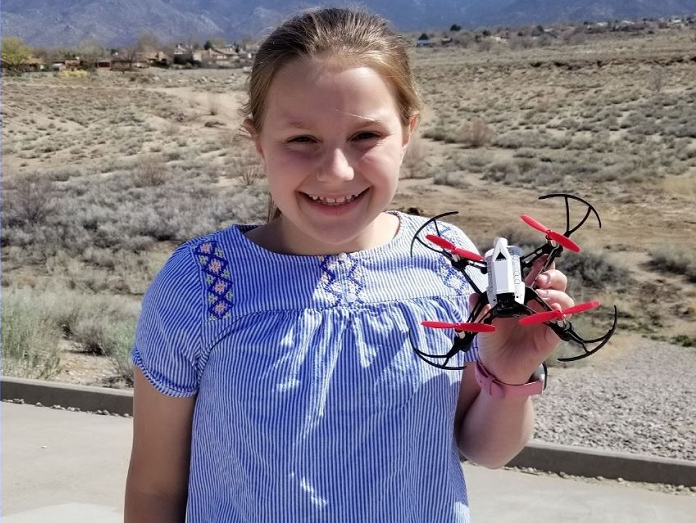
An imaginary elf sits on top of a drone, zipping through “Santa’s Workshop.” The aircraft bobs between snowmen, a giant nutcracker, and reindeer dodging trees and grazing rooftops along the way. The viewer gets a dizzying bird’s-eye view of the entire winter wonderland.
This isn’t Disney’s latest holiday fare, it’s a video production by a fifth-grade girl. Julianna Crowell is a 10-year-old drone pilot who wrote, edited, and flew a drone mounted with a camera to make her concept a reality. Julianna is one of the Fly Girls, an innovative after-school program in Cobb County, Georgia that uses drones to introduce girls in fourth through eighth grades to aerospace.
Before she joined the Fly Girls, Julianna didn’t know much about filmmaking, but it wasn’t long before she created her Christmas-themed project for the program. “It’s fun to fly my drone, and once I accomplish something, if it’s editing a video or filming at all, it’s the highlight of my day,” she said.
Fly Girls is the brainchild of Dr. Sally Creel, STEM and Innovation Supervisor for Cobb County, Georgia Schools. Creel is passionate about increasing the number of women in the fields of science, technology, engineering and mathematics.” Their insights, perspectives and voices are too valuable not to be heard,” she said.
Creel pointed to research that shows girls make up their minds about staying involved with STEM initiatives by the time they enter fourth grade. She and her collaborators chose to create a program around drones because more than 800 aeronautics companies call Georgia home, and aerospace products are Georgia’s number one export.
One of those companies is Lockheed Martin Aeronautics. Cobb County houses one of the corporation’s main aircraft facilities, and Lockheed gives back to the community by providing funding for STEM initiatives within the school system, including Fly Girls. Lockheed’s community relations manager ShaTonya Nicholson said the corporation “looks forward to witnessing the ignition of the ‘STEM Spark’ in young girls.”
Narrowing the Math, Science and Tech Gender Gap
According to a United States Census Bureau report released in January, women are still vastly underrepresented in the fields of science, technology, engineering and math, despite making up nearly half of the U.S. workforce. “Women made gains – from 8% of STEM workers in 1970 to 27% in 2019 – but men still dominated the field. Men made up 52% of all U.S. workers but 73% of all STEM workers,” the report states. Seeking to narrow that gap, Creel has plans to expand Fly Girls statewide and beyond. She has already had conversations with school representatives in Pennsylvania.
Fly Girls participants don’t just learn how to pilot their drones and send them on missions. They also learn about careers that employ the use of drones from women in those professions who are brought in as guest speakers. Creel was particularly impressed by a 26-year-old woman who spoke to the girls.
“She flies drones in the construction industry, not exactly a female-driven field,” Creel said. “She said the cool thing about her job is that all of the foremen have to call her and ask if they can order concrete, which is a big deal in construction. She said, ‘they have to wait for me to say ‘yes’ and that’s empowering.”
Drone piloting may be empowering, but Creel admits it may not be the most alluring hobby. “It’s not like I’m showing them how to be a rap star or something that may be more engaging,” she said. To keep them interested, Creel encourages them to use their footage for storytelling. “They learned how to create storyboards and video editing. I’m so impressed with the tenacity of our young women to get up early on a Saturday morning and participate.”
Ten-year-old Julianna already sees the possibilities that the program has opened up for her. ”There’s not a lot of girls that are involved with drones,” she said. “It used to be all boys and it would be weird if there was a girl who was flying a drone and taking pictures. But now there’s more girl engineers, and it’s much cooler.”

Her father, Ken, is noticing Julianna’s growth as well. “They don’t get the opportunity to see too many women in these technology careers, so it opens their eyes to career paths that may not have been first on their list. Fly Girls has even impacted where Julianna thinks she may want to go to college.”
Tritt Elementary School principal Karen Carstens volunteers with Fly Girls in her spare time, partly because she wants to help erase some of the biases and gender norms in STEM subjects.
“I think it was really powerful to go to these girls and say your teachers think you are so science-oriented, you have the right personality, and I want to personally invite you to this experience. And so we all showed up on a Saturday, and we spent the whole day learning about drones, flying drones, they each got their own drone, and I think it was just so affirming for them to feel seen. I see you for your science and it’s beautiful,” Carstens said.
Fly Girl Riley Wilhoite said she never would have picked up a drone if Carstens didn’t invite her to join the program. “I’m so glad I said yes because it’s brought me into a whole different world of aerospace technology. It’s okay if you’re the first girl to do something or if you’re the only girl there. You should do whatever you want to do,” she said.
At its inception, Fly Girls creators intended to have the young pilots meet in person, learn together, and practice aeronautical acrobatics as a group. But COVID-19 changed that. The girls meet virtually, and do the projects solo.
“The guest speakers inspire me to want to follow in their footsteps,” 10-year-old Cayla Wise said. “It’s really interesting how drones are changing the world. And maybe Fly Girls could change the world.”













